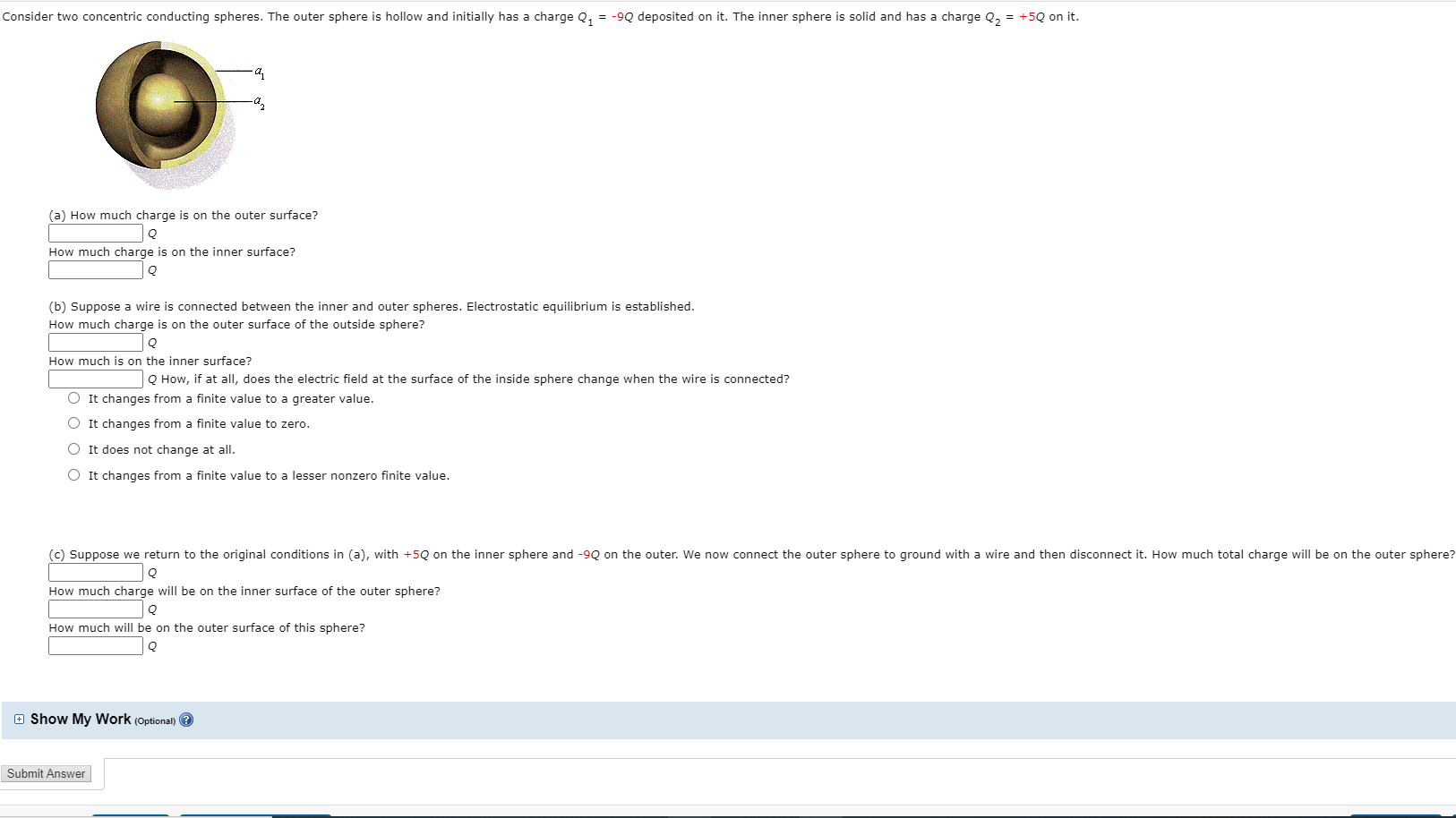Consider two concentric conducting spheres. The outer sphere is hollow and initially has a charge Q, = -9Q deposited on it. The inner sphere is solid and has a charge Q, = +5Q on it. (a) How much charge is on the outer surface? How much charge is on the inner surface? (b) Suppose a wire is connected between the inner and outer spheres. Electrostatic equilibrium is established. How much charge is on the outer surface of the outside sphere? How much is on the inner surface? Q How, if at all, does the electric field at the surface of the inside sphere change when the wire is connected? O It changes from a finite value to a greater value. It changes from a finite value to zero. O It does not change at all. O It changes from a finite value to a lesser nonzero finite value. (c) Suppose we return to the original conditions in (a), with +5Q on the inner sphere and -9Q on the outer. We now connect the outer sphere to ground with a wire and then disconnect it. How much total charge will be on the outer sphere How much charge will be on the inner surface of the outer sphere? How much willI be on the outer surface of this sphere?
Consider two concentric conducting spheres. The outer sphere is hollow and initially has a charge Q, = -9Q deposited on it. The inner sphere is solid and has a charge Q, = +5Q on it. (a) How much charge is on the outer surface? How much charge is on the inner surface? (b) Suppose a wire is connected between the inner and outer spheres. Electrostatic equilibrium is established. How much charge is on the outer surface of the outside sphere? How much is on the inner surface? Q How, if at all, does the electric field at the surface of the inside sphere change when the wire is connected? O It changes from a finite value to a greater value. It changes from a finite value to zero. O It does not change at all. O It changes from a finite value to a lesser nonzero finite value. (c) Suppose we return to the original conditions in (a), with +5Q on the inner sphere and -9Q on the outer. We now connect the outer sphere to ground with a wire and then disconnect it. How much total charge will be on the outer sphere How much charge will be on the inner surface of the outer sphere? How much willI be on the outer surface of this sphere?
Physics for Scientists and Engineers: Foundations and Connections
1st Edition
ISBN:9781133939146
Author:Katz, Debora M.
Publisher:Katz, Debora M.
Chapter23: Electric Forces
Section: Chapter Questions
Problem 42PQ: Three identical conducting spheres are fixed along a single line. The middle sphere is equidistant...
Related questions
Question
100%

Transcribed Image Text:Consider two concentric conducting spheres. The outer sphere is hollow and initially has a charge Q, = -9Q deposited on it. The inner sphere is solid and has a charge Q, = +5Q on it.
(a) How much charge is on the outer surface?
How much charge is on the inner surface?
(b) Suppose a wire is connected between the inner and outer spheres. Electrostatic equilibrium is established.
How much charge is on the outer surface of the outside sphere?
How much is on the inner surface?
Q How, if at all, does the electric field at the surface of the inside sphere change when the wire is connected?
O It changes from a finite value to a greater value.
It changes from a finite value to zero.
O It does not change at all.
O It changes from a finite value to a lesser nonzero finite value.
(c) Suppose we return to the original conditions in (a), with +5Q on the inner sphere and -9Q on the outer. We now connect the outer sphere to ground with a wire and then disconnect it. How much total charge will be on the outer sphere
How much charge will be on the inner surface of the outer sphere?
How much willI be on the outer surface of this sphere?
Expert Solution
This question has been solved!
Explore an expertly crafted, step-by-step solution for a thorough understanding of key concepts.
This is a popular solution!
Trending now
This is a popular solution!
Step by step
Solved in 3 steps with 2 images

Knowledge Booster
Learn more about
Need a deep-dive on the concept behind this application? Look no further. Learn more about this topic, physics and related others by exploring similar questions and additional content below.Recommended textbooks for you

Physics for Scientists and Engineers: Foundations…
Physics
ISBN:
9781133939146
Author:
Katz, Debora M.
Publisher:
Cengage Learning

Principles of Physics: A Calculus-Based Text
Physics
ISBN:
9781133104261
Author:
Raymond A. Serway, John W. Jewett
Publisher:
Cengage Learning

Physics for Scientists and Engineers with Modern …
Physics
ISBN:
9781337553292
Author:
Raymond A. Serway, John W. Jewett
Publisher:
Cengage Learning

Physics for Scientists and Engineers: Foundations…
Physics
ISBN:
9781133939146
Author:
Katz, Debora M.
Publisher:
Cengage Learning

Principles of Physics: A Calculus-Based Text
Physics
ISBN:
9781133104261
Author:
Raymond A. Serway, John W. Jewett
Publisher:
Cengage Learning

Physics for Scientists and Engineers with Modern …
Physics
ISBN:
9781337553292
Author:
Raymond A. Serway, John W. Jewett
Publisher:
Cengage Learning

Physics for Scientists and Engineers
Physics
ISBN:
9781337553278
Author:
Raymond A. Serway, John W. Jewett
Publisher:
Cengage Learning

Physics for Scientists and Engineers, Technology …
Physics
ISBN:
9781305116399
Author:
Raymond A. Serway, John W. Jewett
Publisher:
Cengage Learning

College Physics
Physics
ISBN:
9781305952300
Author:
Raymond A. Serway, Chris Vuille
Publisher:
Cengage Learning